 |
|
At The Picture Show
|
October 2009
'Wild' at heart
Spike Jonze and Co. pull off the improbable, turning Sendak's classic tale into a beautifully rendered ode to childhood
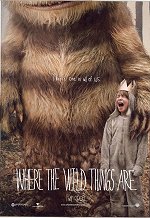
Where the Wild Things Are
Warner Bros. Pictures
Director: Spike Jonze
Screenplay: Spike Jonze and Dave Eggers, based on the book by Maurice Sendak
Starring: Max Records, Catherine Keener, and the voices of James Gandolfini,
Lauren Ambrose, Catherine O'Hara, Forest Whitaker, Chris Cooper and Paul Dano
Rated PG / 1 hour, 34 minutes
Opened October 16, 2009



 (out of four)
(out of four)
It seems most people don't know what the term "kids' movie" means anymore. If
they ever did at all. But if Spike Jonze's wildly nonconformist Where the Wild
Things Are has any legacy at all, it may be the redefining of children's cinema.
Removing the stigma attached to that particular demographic may be a tough task,
but Jonze takes a huge step in the right direction simply by taking kids at face
value. I think there's been a misconception, even among those who admire the
film, that kids simply aren't going to understand it. I believe many of them will
understand it deeply - if, admittedly, not in the same way adults will.
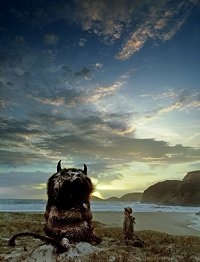 In fact, I'd say that's one of the hallmarks of
the movie - that it gives a voice to the most intangible elements of childhood.
Emotions are inexplicable, chaotic, confusing. Wild. You feel untamable, and the
world around you ripe for conquer. You feel angry and you don't know why.
You're bursting with energies you don't know what to do with. You're growing
up, and you don't know exactly what that means. You're scared. You may not be
all alone, but it sure feels that way.
In fact, I'd say that's one of the hallmarks of
the movie - that it gives a voice to the most intangible elements of childhood.
Emotions are inexplicable, chaotic, confusing. Wild. You feel untamable, and the
world around you ripe for conquer. You feel angry and you don't know why.
You're bursting with energies you don't know what to do with. You're growing
up, and you don't know exactly what that means. You're scared. You may not be
all alone, but it sure feels that way.
In Where the Wild Things Are, all of that - the essence of that very specific
experience of being 8 or 9 or 10 years old - is distilled into an often remarkable
work of empathy and imagination.
This is a near-miraculous film adaptation, an elegiac and mostly unflinching
cinematic poem culled from a mere 10 sentences written 46 years ago.
It speaks to the brilliance of Maurice Sendak's original images that Jonze and co-screenwriter Dave Eggers were so gracefully able to translate all its subtext to the
screen. The result is one of the most honest examinations of childhood I've seen.
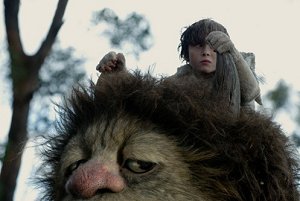 Max (played by newcomer Max Records) is a
pretty typical 9-year-old kid. He builds forts, he likes to play outside, he's roundly
ignored by his teenage sister and his flights of overimagination and mischief tend
to get him into trouble. The day on which the film takes place probably isn't
unlike any other day. He begins by chasing the dog around the house with a fork,
later builds an "igloo" outside and starts a snowball fight, and by nightfall he's
donning that familiarly ragged wolf costume and picking fights with his mother
(Catherine Keener).
Max (played by newcomer Max Records) is a
pretty typical 9-year-old kid. He builds forts, he likes to play outside, he's roundly
ignored by his teenage sister and his flights of overimagination and mischief tend
to get him into trouble. The day on which the film takes place probably isn't
unlike any other day. He begins by chasing the dog around the house with a fork,
later builds an "igloo" outside and starts a snowball fight, and by nightfall he's
donning that familiarly ragged wolf costume and picking fights with his mother
(Catherine Keener).
In these early scenes, we see everything from irrepressible childlike rage (the way
he punishes his sister) to utter tenderness - particularly exemplified during an
extraordinary scene in which he tells his mother a story about vampires losing their
teeth. The story is an innocent, yet powerful signal that Max understands - be it
consciously or subconsciously - the sadness that comes with the gradual leaving
behind of childhood, and the loneliness of being the only one to understand it.
The scene also provides us with a premonition about what his later imaginary
embellishments will come to represent. And we don't have to wait too long for
them, either. Not long after the lovely moment between mother and son, the two
are at each other's throats - he's acting out, be it because Mom's new boyfriend is
over again, or just because he feels like it. The fight gets a bit nasty, Max is sent to
his room, and instead he runs away down the street, eventually finding his way to a
little creek that becomes a vast ocean.
It is on a makeshift sailboat that he finally finds his way to where the wild things
are.
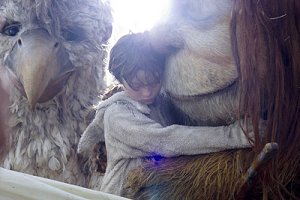 The film's frame story of Max's "real" life is
extremely potent - from the aforementioned opening passages to the final
moments, and final shot, that are pitch-perfect. But that would mean much less if
not for the middle passages, as Max meets a group of Wild Things in a fantastical
forest/desert/ocean that is an astounding piece of production design in and of itself.
The film's frame story of Max's "real" life is
extremely potent - from the aforementioned opening passages to the final
moments, and final shot, that are pitch-perfect. But that would mean much less if
not for the middle passages, as Max meets a group of Wild Things in a fantastical
forest/desert/ocean that is an astounding piece of production design in and of itself.
The gregarious but temperamental Carol (voiced by James Gandolfini in an
inspired bit of casting) is the first to become acclimated with Max, and suggests
that they make him their king. After all, Max insists he has special powers. And
so he becomes their king - despite the revelation that the Wild Things have eaten
all their former kings. Aside from Carol, there's Judith and Ira (Catherine O'Hara
and Forest Whitaker), Douglas (Chris Cooper), Alexander (Paul Dano), The Bull
(Michael Berry Jr.) and the rebellious KW (Lauren Ambrose).
Jonze and Eggers inject the characters with liveliness and specific personalities that
I didn't completely expect, but of course the Wild Things' most essential function
is to serve as a reflection of Max himself. They're going through the same
emotional roller-coaster he is. They, too, act out irrationally. They, too, are
lonely, and scared, and have more love than they know what to do with.
The scenes with the Wild Things are episodic in nature, with certain sequences
paralleling earlier scenes from Max's real life or his relationships with his sister,
his mom and even his dad, who's no longer around. What we see in this world is a
grand tapestry of emotions, fears, dreams and nightmares - everything that a child
experiences but can't fully explain or reconcile.
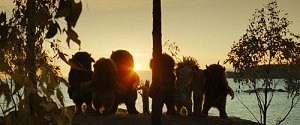 This is what I meant by children (at least those
who are around Max's age and older) being able to understand this film. They'll
recognize what's going on, even if they can't put it into words. It's not unlike the
experience so many of us had reading the book - there wasn't much to the story,
but it spoke to something deeper, and didn't need added contrivance to distract
from it. We knew what it was saying, and we knew how true it was.
This is what I meant by children (at least those
who are around Max's age and older) being able to understand this film. They'll
recognize what's going on, even if they can't put it into words. It's not unlike the
experience so many of us had reading the book - there wasn't much to the story,
but it spoke to something deeper, and didn't need added contrivance to distract
from it. We knew what it was saying, and we knew how true it was.
Where the Wild Things Are tries to see the world through a child's eyes -
acknowledging, of course, that a child's eyes are much more sophisticated than we
so often give them credit for being. What the film shows us is something ominous
and intractable; it sees children as rather courageous to deal with it the way they do
- and sees that as something to be celebrated. And mourned. After all, childhood
won't last very long.
Read more by Chris Bellamy